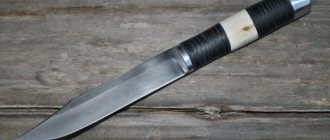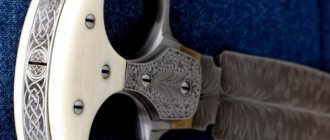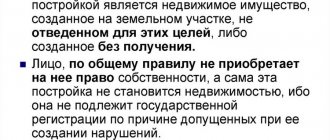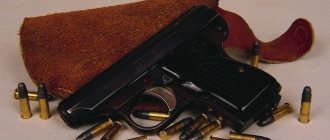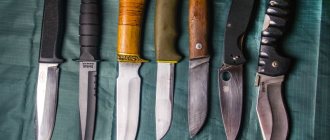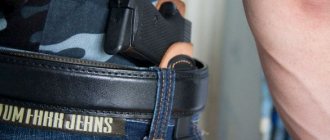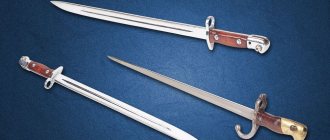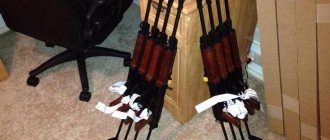Edged weapons are weapons that are used to hit a target using human muscle power through direct contact with the target. Such weapons can be piercing, slashing, piercing-cutting, crushing, and the like. Therefore, edged weapons include Finnish knives, daggers, knives, checkers, sabers, stilettos, brass knuckles, dirks and other objects that are specially adapted or directly intended to hit a living target.
Weapons are not products that are certified as products for industrial or household purposes. These are garden, shoe, kitchen, penknives and the like. You should know that there is responsibility for storing and carrying bladed weapons in 2022. This should be taken into account when purchasing metal products of a piercing or cutting nature. The issue of recognizing a certain object as a cold weapon is decided by forensic examination.
Distinctive features of edged weapons
Melee weapons have the following distinctive features:
- blade length is over 90 mm;
- blade thickness is over 2.4 mm;
- the angle of convergence of the butt and blade is no more than 70 degrees;
- the blade roll is no more than 9 mm;
- steel hardness is at least 25 Rockwell;
- the blade penetrates to a depth of at least 20 mm;
- there is a pronounced limiter for the fingers;
- the tip of the blade, which is convenient for stabbing in the presence of the other above point;
Edged weapons can be recognized as such only based on the results of certification or forensic examination. Punishment for carrying a bladed weapon may occur in the absence of a permit.
Is it legal to carry a knife with you, at what age?
According to the law of the Russian Federation, you can carry a knife with you from the age of 18, but only if it does not fall under the definition of “edged weapon”. The criteria for this concept are the following characteristics of knives:
- the blade from the tip to the stop has a length of 90 mm or more;
- the thickness of the knife in the butt area varies from 2.6 to 6 mm;
- blade hardness level according to Rockwell 42 or more (this data can be found in the product certificate);
- the handle belongs to the injury-proof category - it has a guard of at least 5 mm or recesses for the fingers;
- the blade is sharply sharpened.
For a knife to be recognized as a bladed weapon, all of the listed characteristics must be present - the absence of even one makes the product safe from the point of view of the law.
In general, the law of the Russian Federation regulates the carrying of knives in Article 222 of the Criminal Code. Violation of the law is punishable by the court, and this can be:
- restriction of freedom up to 3 years;
- imposition of labor service (paid forced labor) for a period of up to 4 years;
- Isolation of the offender for up to 4 years and the simultaneous imposition of a fine in the amount of 80 thousand rubles (possibly without monetary penalty).
What knives require a permit?
It is necessary to obtain official permission to store and carry knives if they have the characteristics of a bladed weapon. The license is issued by the internal affairs bodies, for which the owner of the knife must submit a corresponding application. The license period is 5 years, but to obtain it you also need to pass a medical commission, which will confirm that the applicant has no mental disorders and has excellent vision.
Permission can only be obtained if you have a safe for storing bladed weapons. You only need to carry a knife that falls under the category of edged weapons together with a license, which is kept in a sheath.
What size is possible without permission - permissible blade length for wearing
The Federal Law “On Weapons” determines the length of a knife that can be carried without permission not by the width, but by the length of the blade - no more than 90 mm. Even if the product fits perfectly in the hand, has a sharp edge, is suitable for piercing and cutting injuries, but has a length of 89 mm, then it automatically ceases to be considered a bladed weapon requiring a special permit/license.
This length limitation is not accidental - a blade that is too large is not convenient for household use.
What should the handle be like?
The choice of handle is strictly individual, because a person will give preference to one material. Many people like wooden or birch bark knife handles, young people prefer plastic or elastron, aesthetes prefer leather. From the point of view of the law regarding the legal carrying of a knife, this nuance does not play any role - the material of the handle can be absolutely any. But here's what to remember:
- wood absorbs odors and moisture even with specific processing;
- It is better not to wet birch bark and skin at all;
- plastic and elastron are universal, practical materials that do not crack even when exposed to external factors for a long time.
Knife steel
The blade can be bendable/plastic or hard - it all depends on what kind of steel is used in the manufacture of the product. In the first case, the knife will become dull very quickly, but you can sharpen it on a whetstone/stone for sharpening yourself. Hard steel, high quality, requires a more professional attitude - for example, to sharpen such a blade you will need to seek help from a master.
From the point of view of the law, it is important to use a knife and carry it with you only with steel, the level of hardness of which does not exceed 24 units - already 25 units are a reason to recognize the product as a cold weapon and prosecute a citizen under an article of the criminal code in the absence of a license. Watch the video on how to carry a knife:
Watch the video on how to carry a knife:
What bladed weapons are prohibited?
The article of the Criminal Code of the Russian Federation on the carrying of edged weapons prohibits the circulation as service weapons, including civilian weapons, of boomerangs, shurikens, brass knuckles, flails, as well as other objects specially adapted for use as weapons with throwing and impact-crushing action. In Russia, according to Article 6 of the weapons law, the circulation of the following weapons as service weapons, including civilian weapons, is prohibited:
- knives and bladed weapons, blades and blades have a length of more than 90 mm:
- are removed from the handle automatically by pressing a button or a special lever, and are also fixed by them;
- are extended using accelerated movement or gravity, and are also locked automatically.
Typology
It is a license issued by the Internal Affairs Authority at the place of residence. There is an established opinion regarding the correct transportation of products in this category. And many police officers adhere to it. Thus, it is considered correct to carry bladed weapons along with accompanying documents in a bag or backpack. At the same time, of course, when detained by police, one can try to explain that the knife in the case on the belt is not a means of self-defense and is hanging solely for convenience. Moreover, the law does not stipulate where exactly it should be kept during transportation. Of course, you should have the relevant documents with you. Otherwise, it will be difficult to prove anything.
Transportation procedure
In the 70s of the previous century, ordinary citizens were forced to look for means to ensure their safety while on city streets. This was due to a sharp increase in crime. Over the next decade, the volume of manufactured bladed weapons for concealed carry increased significantly. Initially, manufacturers took as a basis the developments of the above USS and USO. Subsequent improvements in the designs of bladed weapons for concealed carry followed the development and implementation of new devices, reducing the size of the blade itself while simultaneously increasing its cutting or piercing properties. Products disguised as ordinary objects were also produced.
More to read —> The apartment was sold during his lifetime according to the will
Currently, in order to obtain a license to store and carry bladed weapons, you do not need to be a superman. You just need to come to the government agency that has the right to issue such permits, write an application, pay a small state fee of no more than two thousand rubles and undergo a short medical examination. Then wait a little time and get the finished paper in your hands. With it, a person will not receive any punishment and will own bladed weapons legally. Therefore, you should not risk your money, time, and maybe even freedom, but you should do everything according to the law and obtain the appropriate permission, and then purchase the edged weapon you like.
In this article you learned about carrying knives. If you have any questions or problems that require the participation of lawyers, then you can seek help from the specialists of the Sherlock information and legal portal. Just leave a request on our website and our lawyers will call you back.
What is not considered a bladed weapon?
Criminal liability awaits those who illegally sell bladed weapons. The Criminal Code of the Russian Federation, and in particular Article 222, part four, states that for the sale of edged weapons, any person will be punished in the form of:
According to GOST, a sharpened knife should cut a birch branch with a thickness of 10-12 mm with a humidity of about 12% 5-6 times, leaving a smooth, burr-free cut. Law enforcement agencies tend to define sharpening of a knife as simply removing the cutting edge.
What bladed weapons are citizens entitled to have?
The rules for carrying edged weapons require a license for it.
- Citizens who have permission to carry, including storage of hunting firearms, have the right to purchase hunting bladed weapons. When purchasing this weapon, the seller notes the entry in the citizen’s hunting license. In this case, a permit to carry this bladed weapon will be a permit to carry a hunting weapon.
- Some citizens can also buy bladed weapons, which are used to wear with the national costumes of the peoples of Russia, as well as Cossack uniforms. These are daggers, knives, checkers and sabers. The Russian government determines the attributes of national costumes.
In other cases, carrying edged weapons is prohibited.
Which blade requires a license
The Law “On Weapons” clarifies some points related to the names and classification of individual samples and types, but does not eliminate all problems in weapons legislation. And there are a lot of them, and they continue to accumulate, creating a truly dangerous trend.
The RG correspondent's interlocutors in law enforcement agencies and intelligence services do not hide the fact that they will be quite satisfied with even the complete lifting of all restrictions on the possession of edged weapons, no matter how paradoxical it may sound. If only there was at least some certainty.
Why does liberalization even seem preferable? The current law regarding bladed weapons is vague, vague and opens wide scope for corruption, abuse of power and other abuses.
Here is the legal definition of the very concept of “edged weapon”: “Edged weapon is a weapon designed to hit a target using human muscular power in direct contact with the target.” By law, bladed weapons include sabers, sabers, knives, daggers, Finnish knives, daggers, brass knuckles, stilettos and other objects specifically designed or adapted to hit a living target. They can be piercing, piercing-cutting, chopping, crushing, etc.
Such handmade exotic weapons are very expensive. But it is sold without permits. Photo: Photoxpress
And here’s a loophole: weapons do not include products certified as household and industrial products (penknots, kitchen knives, shoe knives, garden knives, etc.) that are structurally similar to bladed weapons.
In a specific case, the issue of recognizing a particular item as a cold weapon can be resolved with the help of forensic examination. And examinations are carried out on the basis of departmental instructions and standards of the Ministry of Internal Affairs. That is, a knife with a blade length of 90 millimeters or more can be recognized by experts as a weapon. And a machete with an almost meter-long blade is an entrenching tool. Just like the favorite weapon of the Russian army special forces and infantry in general - a small sapper blade. Or - a small hatchet, a sharpened screwdriver, a shoe awl. But you can kill with a sewing needle. And again a paradox: this very needle is a murder weapon, but at the same time it is by no means a bladed weapon. In general, the regulations for such an examination are internal instructions of the law enforcement agency, which an ordinary citizen is not required to know. And if so, what significance does it have for the court? Well, a man bought a piece of hardware he liked at the market. He didn’t know that this was precisely a bladed weapon. Prohibited for sale. And in general, if a kitchen knife has long been recognized as a “weapon of mass destruction” in Russia - it is with this item that most domestic murders are committed - then what is the real point in such an examination? An example of absurdity: the editors of RG received a letter from a vigilant citizen with a proposal to register absolutely all axes as weapons. Why not pitchforks and scythes?
At the same time, in every store specializing in the sale of edged weapons, you can freely purchase any knife - from a penknife to a real Nepalese kukri. This is the national weapon of the British Gurkha special forces, similar to a small scimitar. With this scimitar, a skilled fighter takes off the head of a bull with one blow - they have such a test for professional suitability. So, when selling such a “trinket,” the seller will definitely give you a certificate, which, on behalf of the expert commission, will indicate that this product is not a bladed weapon, but just a souvenir or a tourist knife. Everything will be certified with seals and someone’s signatures. And not a single policeman will find fault - you will always prove that the knife was purchased legally in a particular store.
In trade ruins you can find anything, even edged weapons from past wars. Even bayonets prohibited by the Geneva Convention
You can also buy a real tomahawk, bow, crossbow, whip, or even a sword. Some stores even offer to check the quality of the product. For example, cutting a centimeter stick with a knife or piercing an army helmet with a tomahawk. And this, according to the certificate, will always turn out to be anything but a weapon. This is the first example of profanation.
The samurai katana sword can hang on the carpet. But problems with the law will arise if you go out into the street with a sword. Photo: Zummolo/ istock
But is it possible to become the legal owner of officially recognized bladed weapons? It is possible if you are, say, a hunter. At a gun store, you show your permit to own a firearm and have the right to buy a knife with a number on it. By law, this number must be reported to the licensing department and entered into the hunting license. And here is the second example of profanation: the incident is that with the introduction of new models of hunting tickets, they do not provide any information at all about the weapon of its owner - neither a gun nor a knife. And if a permit is issued for each firearm, then bladed weapons are not registered at all in the departments of the licensing and permitting system. Of course, there is no database either.
Federal Law on Weapons (150-FZ) 2021
Revision of the law from 01/15/2011 Revision of the law from 06/15/2010 Revision of the law from 04/11/2010 Revision of the law from 04/01/2010 Revision of the law from 01/01/2010 Revision of the law from 02/24/2009 Revision of the law from 01/11/2009 Revision of the law from 03/18/2 008 Revision of the law dated 08/14/2007 Revision of the law dated 01/01. 2007 Revision of the law from 08/07/2006 Revision of the law from 07/01/2004 Revision of the law from 05/10/2004 Revision of the law from 12/27/2003 Revision of the law from 07/01/2003 Revision of the law from 01/15/2003 Revision of the law from 08/10/2002 Revision of the law from 2 06/8/2002 Revision of the law dated 11/29/2001 Revision of the law dated 11/08. 2001 Revision of the law from 07/31/2001 Revision of the law from 04/14/2000 Revision of the law from 11/23/1999 Revision of the law from 12/22/1998 Revision of the law from 07/01/1997 Don’t even try to look for a newer one - this is the latest edition The law was checked today at 10:30:50 Contract-Yurist.Ru constantly monitors the updating of codes and laws.
What is considered a piercing weapon?
According to the principle of destructive action, edged weapons are divided into chopping, piercing, piercing-cutting, impact-crushing, throwing and piercing-cutting. The latter is usually called a bladed weapon, the warhead of which forms a stab wound (clause 3.9 of GOST R 51215-98). Piercing and cutting weapons, for example, are arit (Malayan war sickle), sword, rapier, combat and short sword, dagger, knife, pchak (national knife of the Uzbeks and Uyghurs), skramasaks (short sword of the ancient Germans), sovnya (pole weapon) , saber, folding knives, navaja (large folding knife of Spanish origin), bayonet knife, trench knife, saber.
However, according to weapons expert Vyacheslav Vaneev , there are very vague rules in weapons legislation regarding edged weapons. “In fact, this is a very vague concept. According to Techprim, 20 criteria must be simultaneously taken into account that would allow the identification of piercing and cutting weapons. The most important thing is that if, for example, 18 of the signs are present, but two are not, it means that a piercing-cutting object cannot be classified as a piercing-cutting weapon,” says Vaneev.
License to carry weapons
Permission to purchase and carry weapons is obtained from the licensing department of the Ministry of Internal Affairs at the place of residence. To do this, you need to prepare the following documents:
- statement;
- passport with copies;
- medical certificate that the citizen is allowed to use weapons;
- two 3x4 photographs;
- check for payment of state duty - 350 rubles.
Persons over 18 years of age who have Russian citizenship can obtain a weapons license. A sample application can be obtained from the licensing department of the OLRR or on the State Services website (https://www.gosuslugi.ru/106396/2).
The license validity period is 5 years.
Responsibility measures for using and carrying chemical weapons?
Several codes regulate this issue. We are talking about administrative and criminal codes. As a result, we can say that such violations may result in administrative punishment or lead to criminal liability.
Let's consider the existing liability measures:
- Administrative (part 4 of article 20.8 of the Code of Administrative Offenses of the Russian Federation). Until 2003, carrying a bladed weapon was punishable by imprisonment for 2 years, but today there is a fine of 200-500 rubles and deprivation of permission to carry for up to a year.
- Criminal (Part 4 of Article 222 of the Criminal Code of the Russian Federation). For the sale and manufacture of such weapons, compulsory labor may be assigned for a period of up to 480 hours. Imprisonment in such circumstances can be up to 2 years, plus a fine of 80 thousand rubles.
In practice, crimes using chemical weapons are not often committed, but there are other types of weapons that pose no less danger today. Not all cases are classified correctly, since not all types of weapons can be classified as bladed weapons. For example, souvenir weapons are not included in the above category.
What to do with old knives
The problem of disposing of old knives is no less pressing than all others. On the one hand, there is no point in storing things in the house that are not suitable for use. On the other hand, shackled by numerous superstitions, people are afraid to throw away old or broken knives.
What to do in this case is suggested by folk signs. You can clean it and throw it into a river with running water, throwing in a couple of small coins after it. Or bury it somewhere in the garden. But if a damaged knife goes straight into the trash container, then there won’t be much trouble. This solution to the issue is quite acceptable.
